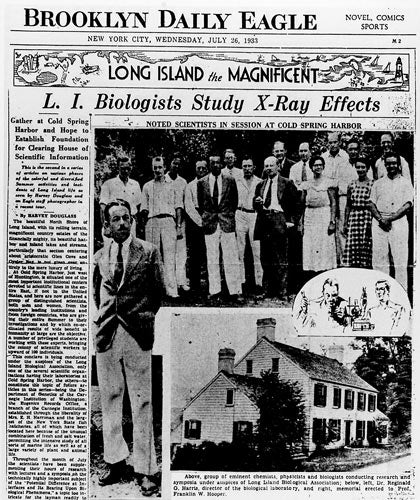Long Island Biological Association
 The Biological Laboratory in Cold Spring Harbor, New York was formerly a department of the Brooklyn Institution of Arts and Sciences (BIAS). Due to an increased demand by biologists and neighbors upon the laboratory for adequate facilities and equipment, BIAS approved the plan to transfer the control of the laboratory to a group of scientists and prominent local citizens that formed the Long Island Biological Association (LIBA). In 1924, BIAS transferred land, buildings, monies and funds to LIBA. LIBA took over the administrative duties of the laboratory. LIBA employed various means of fundraising that were successful and resulted in increased revenue for the laboratory. Membership support from the community and friends was the most successful of the fundraising endeavors. In 1962, due to the Carnegie Institution of Washington’s decision to discontinue its Genetics department at Cold Spring Harbor Laboratory, a new organization was formed called The Cold Spring Harbor Laboratory of Quantitative Biology. Its control and sponsorship were governed by various universities and other scientific institutions. Under the new leadership, LIBA became one of the sponsoring institutions. LIBA continued its role of maintaining and acquiring membership support from the community and associates; however, gave up its management role of the Biological Laboratory.
The Biological Laboratory in Cold Spring Harbor, New York was formerly a department of the Brooklyn Institution of Arts and Sciences (BIAS). Due to an increased demand by biologists and neighbors upon the laboratory for adequate facilities and equipment, BIAS approved the plan to transfer the control of the laboratory to a group of scientists and prominent local citizens that formed the Long Island Biological Association (LIBA). In 1924, BIAS transferred land, buildings, monies and funds to LIBA. LIBA took over the administrative duties of the laboratory. LIBA employed various means of fundraising that were successful and resulted in increased revenue for the laboratory. Membership support from the community and friends was the most successful of the fundraising endeavors. In 1962, due to the Carnegie Institution of Washington’s decision to discontinue its Genetics department at Cold Spring Harbor Laboratory, a new organization was formed called The Cold Spring Harbor Laboratory of Quantitative Biology. Its control and sponsorship were governed by various universities and other scientific institutions. Under the new leadership, LIBA became one of the sponsoring institutions. LIBA continued its role of maintaining and acquiring membership support from the community and associates; however, gave up its management role of the Biological Laboratory.
Documents within the collection identify these records as those belonging to the Long Island Biological Association. During most of its existence the organization shared directors, certain staff and buildings, with three related peer institutions:
- Carnegie Institute of Washington
- Eugenics Record Office (established as a separate entity in 1910, but whose building, files and records were donated to Carnegie Institution of Washington in 1918);
- The Brooklyn Institute of Arts and Sciences The Biological Laboratory (see Related Collections; Cold Spring Harbor Organization Timeline.)
This shared leadership created an intermingling of these institutions’ administrative files. Where folders were clearly identifiable as belonging to another institution as determined by date, person, or subject, the processing archivists removed the folders for placement in the relevant Related Collections. Where folders contained material which overlapped multiple collections, the folder was kept in this collection and reference notes added. It is recommended that this collection be researched in conjunction with Related Collections. This collection was processed in June 2012.
 This collection was processed under a 2011-2012 DHP award. Funding provided by the New York State Education Department’s Documentary Heritage Program.
This collection was processed under a 2011-2012 DHP award. Funding provided by the New York State Education Department’s Documentary Heritage Program.